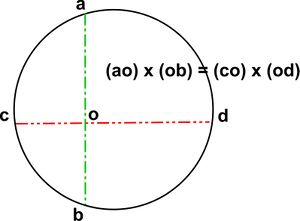Intersecting Chords: Difference between revisions
From DT Online
m (Added category link) |
(Improved presentation) |
||
| Line 1: | Line 1: | ||
[[File:ChordTheorem.jpg| | [[File:ChordTheorem.jpg|300px|right]] | ||
This theorem relates to a characteristic of a [http://en.wikipedia.org/wiki/Cyclic_quadrilateral#Characterizations '''cyclic quadlitateral'''], the diagonals of which are two intersecting chords of the circumscribing circle. | This theorem relates to a characteristic of a [http://en.wikipedia.org/wiki/Cyclic_quadrilateral#Characterizations '''cyclic quadlitateral'''], the diagonals of which are two intersecting chords of the circumscribing circle. | ||
The [http://www.mathopenref.com/chordsintersecting.html '''Intersecting Chords Theorem'''] states that the relationship '''''(ao x ob = co x od)''''' is true for <u>'''any'''</u> two intersecting chords, whether or not one of them is a diameter. | |||
{| cellpadding="5" | |||
|- | |||
| '''Measuring Beam Deflections''' | |||
| <span style="color:#B00000"> | |||
The theorem can be useful when measuring the radius of bending of a deflected beam if one of the chords is taken to be the length of the beam | |||
e.g. | e.g. | ||
* set up a strip of material as a simple beam | |||
* note the distance between supports '''''(cd)''''' | |||
* apply a central load to make it bend - or '''''[[Beam Deflection|‘deflect’(Δ)]]''''' - therefore '''co = od = ½cd''' | |||
* measure the deflection '''''(ob)''''' | |||
Bending Radius (R) can be calculated as follows: | Bending Radius ''(R)'' can be calculated as follows: | ||
* ao x ob = co x od | * ao x ob = co x od | ||
* (2R-Δ) x Δ = ½cd x ½cd | * (2R-Δ) x Δ = ½cd x ½cd | ||
* but, for small deflections, Δ<sup>2</sup> will be negligible | * but, for small deflections, Δ<sup>2</sup> will be negligible | ||
* so R = cd<sup>2</sup> ÷ 8 x Δ | * so R = cd<sup>2</sup> ÷ 8 x Δ | ||
''(see ‘Structures’ by [http://en.wikipedia.org/wiki/J.E._Gordon J.E.Gordon] ISBN 0 14 02.1961 7)'' | ''(see ‘Structures’ by [http://en.wikipedia.org/wiki/J.E._Gordon J.E.Gordon] ISBN 0 14 02.1961 7)'' </span> | ||
|[[File:DeflectedBeamChords.jpg|400px|right]] | |||
|} | |||
[[Category:Secondary]] | |||
[[Category:Structures]] | [[Category:Structures]] | ||
[[Category:Terminology]] | |||
Revision as of 08:59, 27 February 2015
This theorem relates to a characteristic of a cyclic quadlitateral, the diagonals of which are two intersecting chords of the circumscribing circle.
The Intersecting Chords Theorem states that the relationship (ao x ob = co x od) is true for any two intersecting chords, whether or not one of them is a diameter.
| Measuring Beam Deflections |
The theorem can be useful when measuring the radius of bending of a deflected beam if one of the chords is taken to be the length of the beam e.g.
Bending Radius (R) can be calculated as follows:
(see ‘Structures’ by J.E.Gordon ISBN 0 14 02.1961 7) |
